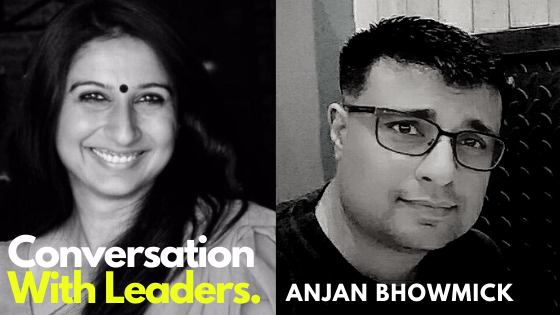Future Of Learning Is a Mindset Change, Says OD Expert, Anjan Bhowmick

Note from the Editor: Ungender Insights will now feature an occasional longform feature from industry leaders or the blog team. This series is a new addition to the blog. We believe that longform content is important for our area of work and also relevant to readers who value insight on topics that are often complicated, nuanced and take time to grasp. While it is absolutely true that we are living in the instant-gratification age of short attention spans – we think it is important to sometimes present the “whole story”. We hope you enjoy these pieces.
This interview has been edited for longform text.
Written By: Rituparna Chatterjee
You could say Anjan Bhowmick, our recurring guest on Ungender Legal Advisory events, is one of our favourite speakers for his deep understanding of organisation development and the all-important role it plays in shaping a company’s work processes, tying these processes in with diversity, inclusion and cost-effective changes for virtual realities of tomorrow. Bhowmick currently works with the Reinsurance Group of America, Incorporated (RGA) as Executive Director, Talent and OD for Asia and Australia markets. In an hour-long video chat with Ungender founder and CEO, Pallavi Pareek, Bhowmick speaks at length about Future of Learning, how workplaces need to change to accommodate the new normal of virtual working, and how top leadership can empathetically make that shift.
Q: What are the shifts in the “learning and development” space at workplaces? What will change?
A: I can think of three broad ways. The first of these is the fact that Learning and Development (L&D) is actually getting more and more broad-based across functions. L&D is now more than HR-led learning that only seeks to augment supply to the business, one could characterize it as a continuum of sales, marketing and HR.
So when one looks at it from a performance measurement perspective – L&D is now an enterprise learning parameter, it is not a parameter one uses to assess HR or OD alone.
For example, in sales, earlier we used to go and assess the potential of a market of a product by physically visiting outlets. The way this worked is that a potential market would be defined by the number of shops on a route say 50 that could stock a product, so therefore if a route had 50 shops the market potential for the product would be 50 shops. With the new normal, I’m not sure if a salesperson would be able to go to 50 outlets at all.
Naturally now there is a lot of focus instead, on modelling market sizes by say using representative samples of outlets and then projecting this to ask, “hey, this is what it is for xxx route, what would it look like for a bigger route or a bigger market?” That’s a complete mindset change and are we geared for it? I really don’t know. This explains the increasing focus on modelling predictive analytics in functions like sales.
Health companies, for example, are looking at the benefits of disseminating information on hygiene and wellness as opposed to focusing on reactive items topics such as what medicine is appropriate and the arguments for or against generic medicines.
The second important thing to note in the context of L&D is the speed of change. To adapt to the new normal — there will clearly be an increased need for resource mobilisation which undoubtedly will be addressed. The key to the whole process though is going to be collaboration, so whoever doesn’t know how to collaborate, will fall out of place. Finally when I think about what is going to change it is also going to be our mindset, the mindset of accepting the fact that we can do work without “going” to work.
Finally, there is the question of readiness. I recently learnt that 65% of the people during COVID said they wanted to get back to work, and that posed a question – does that mean that these people did not want to work from home? The truth is that while everybody can work from home, working from home everyday over a prolonged period of time is very different from working from home on occasion. We really need to work on mindsets and need to be prepared. The way the world has changed is that we might not be in a position to go to office for over a 100 days out of 360 days or more. This coupled with the fact that 65% of our people are actually saying, “I don’t want to stay at home, I just want to go to work” is concerning because clearly these people are not ready to not work from an office space. We need to think about how this plays out vis-a-vis learning and what that means for businesses.
Q: Whatever our understanding of the official environment was, no longer exists, and we don’t know if it ever will exist in the future. You have just told us that mindsets need to change and we think leaders too need to unlearn. Some of the changing mindsets is also about putting new structures in place. So how should other companies go about helping their team members to unlearn?
A: I think a lot of leaders are beginning to be more flexible. It is a fact that working from home means that work life balance will blur. My experience is that company leaders, at least in the Indian subcontinent, at least in my company, have been extremely empathetic while employees are adjusting to the work from home situation.
I’ll share an anecdote – I was conducting a staff meeting with my global HR and OD teams and was told by the head of HR, “look, we understand what you’re going through. There is a sense of mental fatigue that you go through when you work. You don’t know when to stop working and start your personal life. But in calls like this, we’re okay if your Alsatian appears on camera in front of you or your kid comes and starts crying while you are talking to us.. or your coffee comes on the table.”
We would, possibly not welcome that level of flexibility, in a structured official place of work. Leaders now wish to be a little more empathetic and they need to be flexible too. To allow that room is also human because you cannot avoid your own little kid or your dog or your wife or your mother coming and saying, “you know what, lights have gone off, and it’s time to go to the veggie market”, you can’t. Organisations have to adapt to the fact that the work-life thing is blurring. I see leaders being extremely responsible and empathetic in these times of need.
The other thing which I think leaders need to do, is to be able to catch that 65%, who really want to go back to office and see what would help them or motivate them to work in places, which are away from home, but not all the time.
Q: Everyone formulates plans for the future of their workplaces differently. Despite this, a professional journey for individuals, still requires them to stay up to date on the latest trends that are relevant to growth and better job performance – this is what organisational L&D is supposed to do. Given the new normal, how will this continue?
A: One of the things that we’re talking about is mindsets. There is a mindset that physical learning is more productive than virtual learning. I believe that The frequency of virtual interactions, collaborative communication and learning will increase in the next year. I know that we are aiming for a year of 100% virtual L&D going forward.
From an efficacy standpoint, I would love to know whether virtual learning as we currently experience it, is okay or not okay? Is it creating value? Is it being able to compensate for the loss of physical learning? People will have anecdotal statements, but I would like to test that hypothesis.
In the next 12 to 18 months, a lot of focus in multinational companies spanning multiple geographies will hover around instant collaboration and virtual learning. The challenge will be “how do I create an experiential atmosphere?” Learning will happen, so I like to talk positively about virtual learning, because it’s going to stay for a couple of months. The last point that I want to make is about the consequences of the opening up of virtual learning in terms of opportunity. People who do or will have to create these programmes will start comparing the physical and virtual. How costly is physical learning? How costly is virtual learning? Is it value for money? These are important questions to have answers to.
Q: Tell us more about the infrastructural, cultural and behavioural changes that decision makers need be cognizant of in creating L&D going forward?
A: Currently decision makers are in an extremely exploratory mode. While decisions are being made it is hard to think that all the answers are there. I think one of the things that decision makers should think about is building a positive resonance around learning in a different way.
Bear in mind that we are a group of people, globally, which has Gen X, Gen Z, Gen Y, and next – Gen G members of the Gig Economy (a term used to refer to temporary, flexible jobs featuring the hiring of independent contractors and freelancers), all together. We are the only generation which has these humongous, heterogeneous generations clumped together. When you think that through, in terms of diversity, we have leaders representing generations across and we clearly need to start building positive reinforcement around virtual learning, which works for all of these people types.
The other thing decision makers need to do is to start hedging the probabilities. So if I were a decision maker, I would think, “Okay fine, I really don’t know how that will work and create value in 2021, but I’m going to hedge 100 million dollars or $50 million on infrastructure, or building capability or enterprise learning…” The underlying idea is that hedging would mean the avoidance of a definite forecast, opting instead for a probabilistic forecast i.e. no “putting all his eggs in one basket” and forecasting a single outcome with 100% probability, hedges bets instead by assigning non-zero probability to more than one possible business outcome.
The third thing that I would like to do, is to encourage decision-makers to emotionally think through decisions, because the concept of unlearning has never been so important. Decision makers have to stop the narrative of “oh, you’re not doing this stuff physically, will it be effective?” in their own heads. We need to bring in leaders and decision makers who are in a position to exercise (freely) what I call the Adaptive Quotient. These are people who have worked in different businesses or firms and have witnessed how business cycles turn out.
I would like to bring in people who’ve dealt with change, experienced different industries, worked in different sectors and those who have faced failures. I would probably bring in an entrepreneur to take decisions because they know exactly how to hedge. So, those are some of the things that I think might be very effective going forward for decision makers.
The problem is not the change. Change is alright, the problem is the speed of change. It’s never been so fast. If you have a L&D organisation and you’re not thinking through the next virtual solution or prototype to deliver the content, you’re on your way to losing that business. So you’ve got to be so fast that it’s breath-taking. Microsoft is crunching a two year plan to a two month plan, which means that you’ve got to be competitive, you’ve got to actually “do” the change.
Q: There are so many options when it comes to virtual learning. There’s distance learning delivered via an integrated platform, AR and VR modules, Zoom and Meet and so much more. Any thoughts on different mediums or shifts in technology or technological advancement more generally?
A: The way I see technology evolving is that creators of learning tech are in a way going to be technology shapers. Technology shapers are going to start designing learner archetypes – these are advanced typologies of how people learn specific subjects to online learning. These exist, but there is scope for refinement and growth and of course evolution.
So, you might have an HR learning platform company, which specialises only in working with HR leaders to devise cost effective, quick and off-the-shelf learning, this is different from an archetype in marketing, or an archetype in R&D or supply chain. In this case, we have similar technology, which have become functional silos, because the silos themselves are now becoming the value creator.
I would love to be funding a technology company only for HR because we really don’t know whether to use Zoom or use Microsoft Teams. So, for these certain functionalities, it would be great to have help on design or advise on what works best given the reality of the function. The essential and fundamental needs assessment will stay; what leads to the design will change. The other thing is investment on technology. One finds a lot of investments that organisations are making on technology as a whole, which to me is critical.
Q: When we talk about inclusion and gender diversity, we still talk about women but not people from the LGBTQIA community, or persons with disabilities. Once the workplace changes (from physical to virtual) and physical ability will perhaps no longer be “important”, will organisations and leaders learn more about the definition of inclusion?
A: If I were to look at productivity, as any business person would — the central concern is not when you come into work and when you go out. Productivity is the output generated in eight hours of work from wherever you are and whoever you are. So, the filters on mobility, gender, maternity or paternity or the demise of a relative is and should be rendered irrelevant. This is an opportunity for corporations and it does open up doors.
How will technology support all this? Going forward, one will have customised enterprise learning. One will have a marketing function IT company or an HR learning IT company. I hope these companies come forward and design learner archetypes that aid persons with disabilities perform at their highest standards at the lowest cost possible, for example. I would want the government to subsidise these products for the masses if possible.
Q: What are the 3-4 things that leaders/decision makers need to know or learn before they plan and draft L&D initiatives for the organisations?
A: The first thing is the need to be savvy at, as people participating in Indian or global growth, is collaborative communication. Skills around collaborative communication really need to be turned around.
The second thing is propagating a growth mindset in everybody, specifically the “agile teams” idea one has to ensure that projects are not 10 or 5 years old. Organisations have to understand that the new normal is also groups of people contributing for three months, forming agile teams, getting stuff done and then moving on to other projects. Decision makers should not set much store by “loyalty” in the face of contribution.
The third thing is identifying skill-sets for talent acquisition — across government, and enterprise. Things like recognising that one doesn’t need to become a super duper presenter with PowerPoint and a suit, one can wear a black tee shirt and talk well too. The skillset to be identified should be collaborative consciousness and collaborative communication.
The fourth point is inclusion. Organisations should not forget that there is a segment of the population that needs handholding and equal opportunity. Opportunity is skewed towards the majority right now and handholding to an underrepresented segment is not doing them a favour, we are bringing in value, innovation and a productive workforce.
About the author: Rituparna Chatterjee is a journalist with close to two decades of experience in journalism, working across media platforms, and tracking ground-up stories of feminist movements, social inequalities, gaps in gender discourse, and communities. She currently oversees communications for Ungender Legal Advisory
This article has been 🖊 edited by Varna
Ungender Insights is the product of our learning from advisory work at Ungender. Our team specializes in advising workplaces on workplace diversity and inclusion. Write to us at contact@ungender.in to understand how we can partner with your organization to build a more inclusive workplace.
Read our insights about diversity, legal updates and industry knowledge on workplace inclusion at Ungender Insights. Visit our Blog.
Sign up to stay up-to-date with our free e-mail newsletter.
The above insights are a product of our learning from our advisory work at Ungender. Our Team specialises in advising workplaces on gender centric laws.
or email us at contact@ungender.in




